HOME SCIENCE
Paper – II
Note : This paper contains fifty (50) objective type questions of two (2) marks each. All questions are compulsory.
1. As per ICMR (2010) the RDA of Thiamin for a moderately active man is
(1) 1.2 mg/day
(2) 1.4 mg/day
(3) 1.1 mg/day
(4) 1.5 mg/day
2. Following is an indicator of deterioration in quality of egg :
(1) Egg shell is intact
(2) Small air cell
(3) Increased alkalinity of egg white
(4) Firm chlazae holding the yolk in the centre
3. Which of the following is not a type of buffet service ?
(1) Finger
(2) Trayed
(3) Full
(4) Fork
4. Which of the following is not a design repeat ?
(1) Half drop
(2) Mirror
(3) Brick
(4) Proportion
5. Which of the following is not a primary property of a fibre ?
(1) Strength
(2) Flexibility
(3) Cohesiveness
(4) Density
6. Identify the term related to flower arrangement.
(1) Feng Shui
(2) Ying-Yang
(3) Ikebana
(4) Alpana
7. _______ applied ethological theory to understand infant-caregiver relationship.
(1) Jean Piaget
(2) John Locke
(3) Albert Bandura
(4) John Bowlby
8. Sarva Shiksha Abhiyan (SSA) was launched in the year
(1) 2001
(2) 2005
(3) 2010
(4) 2015
9. The communication model ‘who says, what, in which channel, to whom, with what effect’ was proposed by
(1) Aristotle
(2) Lasswell
(3) Shannon and Weaver
(4) David Berlo
10. In normally distributed population Mean + 1.96 S.D. will cover _____ of population.
(1) 90%
(2) 95%
(3) 98%
(4) 99%
11. Iodine deficiency disorders include the following :
I. Abortion II. Impaired coordination
III. Impaired skeletal growth
IV. Low Haemoglobin level
V. Mental Retardation
Codes :
(1) I, III, IV
(2) II, III, V
(3) I, II, V
(4) III, IV, V
12. Smoking point of fats is lowered by
I. Repeated heating of fat.
II. Exposing smaller surface area.
III. Development of free fatty acids by some hydrolysis of fat.
IV. Presence of suspended matter such as flour.
Codes :
(1) I, III, IV
(2) I, II, III
(3) II, III, IV
(4) I, II, IV
13. Which of the following methods are used for performance evaluation of employees in a food service establishment ?
I. CCP
II. BARS
III. FIFO
IV. MBO
V. GHP
Codes :
(1) I and III
(2) II and IV
(3) III and IV
(4) IV and V
14. Which of the following are examples of using diagonal line in clothing design ?
I. Raglan sleeve
II. Halter tops
III. Fish darts
IV. Box pleats
Codes :
(1) I and II
(2) II and III
(3) III and IV
(4) I and IV
15. Which of the following fibres when taken away from flame continue burning with an after glow ?
I. Cotton
II. Rayon
III. Silk
IV. Nylon
Codes :
(1) I and II
(2) II and III
(3) III and IV
(4) I and IV
16. Choose the colours used to bring out a split complementary colour harmony :
I. B
II. RO
III. O
IV. YO
Codes :
(1) I, II and III
(2) II, III and IV
(3) I, III and IV
(4) I, II and IV
17. Problems faced by a researcher in conducting longitudinal studies include the following :
I. Cohort effects greater.
II. Sample attrition high.
III. Participant dropout low.
IV. Practise effects more.
Codes :
(1) I, II, III
(2) II, III, IV
(3) I, II, IV
(4) I, III, IV
18. The Psychological barriers in communication can be
I. Stage-fright
II. Day-dreaming
III. Fidelity
IV. Entropy
Codes :
(1) I and II
(2) II and III
(3) III and IV
(4) I and IV
19. Which of the following are non-projected visual aids ?
I. Charts
II. Posters
III. Slides
IV. Graphs
Codes :
(1) I, II and III
(2) II, III and IV
(3) I, III and IV
(4) I, II and IV
20. In a positively skewed distribution, Mean is
I. Greater than Median
II. Smaller than Median
III. Greater than Mode
IV. Smaller than Mode
Codes :
(1) II and IV
(2) I and IV
(3) I and III
(4) II and III
21. Assertion (A) : Sprinkling of salt on cut fruits prevents browning.
Reason (R) : Salt lowers the pH, thus inhibiting the activity of polyphenolase.
Codes :
(1) Both (A) and (R) are correct.
(2) Both (A) and (R) are incorrect.
(3) (A) is correct and (R) is incorrect.
(4) (A) is incorrect and (R) is correct.
22. Assertion (A) : Exclusive Breast feeding for first six months protects the infant from infectious diseases.
Reason (R) : Breast milk provides certain antibodies which develop natural immunity in the infant.
Codes :
(1) Both (A) and (R) are correct.
(2) Both (A) and (R) incorrect.
(3) (A) is correct and (R) is incorrect.
(4) (A) is incorrect and (R) is correct.
23. Assertion (A) : Sound forecasting is vital to financial management in a food production unit.
Reason (R) : Forecasting facilitates efficient scheduling of labour, use of equipment and space.
Codes :
(1) (A) is incorrect, but (R) is correct.
(2) Both (A) and (R) are correct.
(3) (A) is correct, but (R) is incorrect.
(4) Both (A) and (R) are incorrect.
24. Assertion (A): While removing blood stain heat must be avoided.
Reason (R) : Heat coagulates the protein and fixes the stain on the fabric.
Codes :
(1) Both (A) and (R) are correct.
(2) Both (A) and (R) are incorrect.
(3) (A) is correct, but (R) is incorrect.
(4) (A) is incorrect, but (R) is correct.
25. Assertion (A): Textured yarns are not prone to snagging.
Reason (R) : Lesser surface area is available to contact rough or sharp objects.
Codes :
(1) Both (A) and (R) are incorrect.
(2) Both (A) and (R) are correct.
(3) (A) is correct, but (R) is incorrect.
(4) (A) is incorrect, but (R) is correct.
26. Assertion (A): Skill and knowledge are intangible human resources.
Reason (R) : They cannot be touched.
Codes :
(1) Both (A) and (R) are true and (R) is the correct explanation of (A).
(2) Both (A) and (R) are true, but (R) is not the correct explanation of (A).
(3) (A) is true, but (R) is false.
(4) (A) is false, but (R) is true.
27. Assertion (A): Reproductive technologies are evolving faster than societies can weigh the ethics of these procedures.
Reason (R) : Not enough research is available regarding the long term health and psychological consequences of these procedures.
Codes :
(1) Both (A) and (R) are correct.
(2) (A) is correct, but (R) is incorrect.
(3) (A) is incorrect, but (R) is correct.
(4) Both (A) and (R) are incorrect.
28. Assertion (A): Movie stars and sporting heroes are popularly used as Brand ambassadors.
Reason (R) : Attractive communicators (sources) are more effective in persuading for change than unattractive ones.
Codes :
(1) (A) is correct, but (R) is incorrect.
(2) (A) is incorrect, but (R) is correct.
(3) Both (A) and (R) are correct.
(4) Both (A) and (R) are incorrect.
29. Assertion (A): Women lack economic autonomy and sustainable livelihoods.
Reason (R) : Women’s contribution to household and National Economy is not measured in quantitative terms and is not appropriately reflected in the National accounts.
Codes :
(1) Both (A) and (R) are correct.
(2) Both (A) and (R) are incorrect.
(3) (A) is correct and (R) is incorrect.
(4) (A) is incorrect and (R) is correct.
30. Assertion (A): The larger the sample size, the greater will be the power of the test.
Reason (R) : A large sample size results in smaller standard error of mean.
Codes :
(1) Both (A) and (R) are correct.
(2) Both (A) and (R) are incorrect.
(3) (A) is correct and (R) is incorrect.
(4) (A) is incorrect and (R) is correct.
31. Arrange in correct sequence the steps in the production of cheese :
I. Add renin solution for curd formation.
II. Drain the whey from curd.
III. Addition of salt to cheese.
IV. Cutting and pilling of soft cheese.
V. Addition of bacteria or mould for ripening process.
VI. Addition of lactic acid starter to pasteurized milk and keep for 30 minutes.
Codes :
(1) VI, I, IV, II, III, V
(2) I, VI, II, IV, V, III
(3) I, III, II, VI, IV, V
(4) VI, I, II, IV, III, V
32. Arrange in correct sequence the stages in the development of Eye changes due to Vitamin-A deficiency :
I. Conjuctival Xerosis
II. Night-Blindness
III. Keratomalacia
IV. Bitot’s Spot
V. Corneal Xerosis
Codes :
(1) II, IV, III, I, V
(2) II, IV, I, V, III
(3) II, I, V, IV, III
(4) IV, I, V, II, III
33. Arrange the mechanics of waiter service in the correct sequence :
I. Clearing
II. Receiving customers and taking order
III. Serving
IV. Preparation of service bays, sideboards and table
V. Sending off the customer
Codes :
(1) II, III, V, I, IV
(2) IV, II, III, I, V
(3) I, II, III, IV, V
(4) II, III, V, IV, I
34. Give the correct sequence of draping front bodice block on the dress-form :
I. Pinning the muslin at apex and centre front on dress-form.
II. Pinning the muslin on horizontal balance line.
III. Pin side seam and armhole.
IV. Blocking and marking the muslin.
V. Pinning the muslin at vertical balance line.
VI. Pin waist line dart.
VII. Drape the neckline and the shoulder dart.
Codes :
(1) VII, VI, IV, V, I, II, III
(2) IV, I, II, V, VI, III, VII
(3) VII, II, III, IV, V, I, VI
(4) I, II, III, IV, V, VI, VII
35. Give the correct sequence of making nylon :
I. Formation of chips
II. Polymerization
III. Lubrication and crimping
IV. Spinning
V. Drawing
Codes :
(1) II, I, IV, V, III
(2) I, II, V, IV, III
(3) III, II, I, V, IV
(4) I, III, II, IV, V
36. Arrange the various functions of management in proper sequence :
I. Planning
II. Directing
III. Coordinating
IV. Reporting
V. Organizing
Codes :
(1) I, II, III, V, IV
(2) I, V, II, III, IV
(3) I, III, IV, II, V
(4) I, V, III, II, IV
37. Arrange in order of psychosocial stages of development :
I. Industry Vs Diffusion
II. Initiative Vs Guilt
III. Intimacy Vs Isolation
IV. Identity Vs Identity Confusion
Codes :
(1) II, IV, I, III
(2) I, II, III, IV
(3) II, I, IV, III
(4) I, II, IV, III
38. Arrange the steps of programme planning used by development agencies :
I. Provide for evaluation.
II. Prepare a summary of the current situation.
III. Prepare action programme with methods and Activities.
IV. Select problem for intensive action.
V. Designate local leaders for each problem.
Codes :
(1) I, V, IV, III, II
(2) II, IV, V, III, I
(3) III, IV, V, I, II
(4) IV, V, I, II, III
39. Arrange the following audio-visual aids in the learning continuum from bottom to top as per the Edgar Dale’s ‘Cone of Experience’ :
I. Contrived experiences
II. Exhibits
III. Direct, purposeful experiences
IV. Demonstrations
V. Field trips
VI. Dramatised experiences
Codes :
(1) III, II, VI, IV, V, I
(2) III, II, IV, V, VI, I
(3) III, I, VI, IV, V, II
(4) III, I, VI, V, IV, II
40. Arrange in correct sequence the steps for testing Statistical Hypothesis :
I. A random sample is drawn from population.
II. Specify the level of significance.
III. Value of the sample statistic is obtained.
IV. Obtained sample statistic is examined with the random sampling distribution of the statistic under consideration.
V. Formulate Null Hypothesis about a parameter of the population, along with an alternate hypothesis.
VI. Retain Null Hypothesis if particular sample outcome is in line with the expected outcomes, otherwise reject it and retain alternate hypothesis.
Codes :
(1) I, II, V, III, IV, VI
(2) II, I, III, IV, V, VI
(3) V, II, I, III, IV, VI
(4) I, III, II, V, IV, VI
41. Match the nutrients in List – I with their functions in List – II :
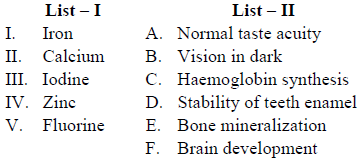
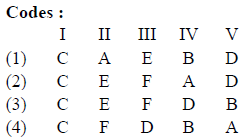
42. Match the pigments in List – I with foods in List – II :
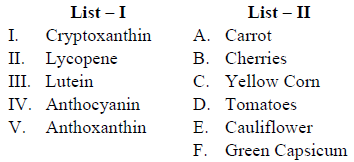

43. Match the type of menu in List – I with its characteristic in List – II :

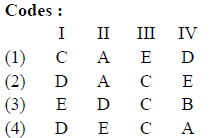
44. Match the terms given in List – I with their descriptions given in List – II :
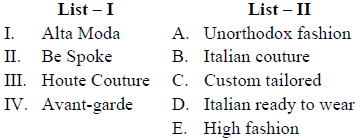

45. Match the fabrics given in List – I with their descriptions given in List – II :

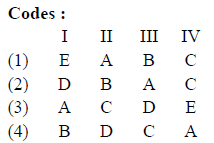
46. Match the items given in List-I with items given in List-II

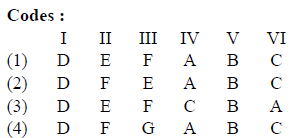
47. Match the concepts in List – I with their meaning in List – II :


48. Match the items given under List – I with the appropriate items given under List – II :

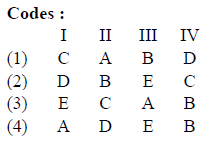
49. Match the concept used in Entrepreneurship given in List – I with their descriptions given in List – II :
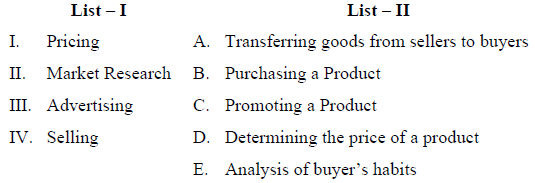
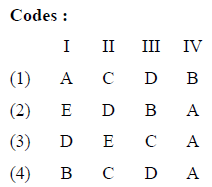
50. Match the items in List – I with List – II :
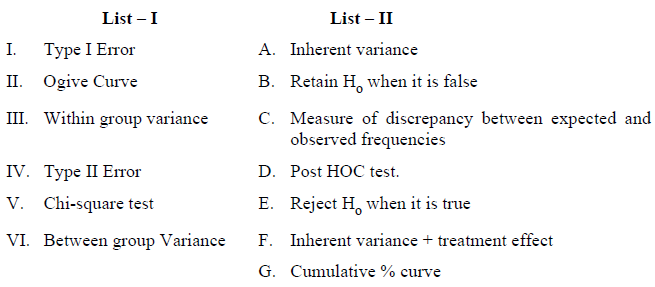
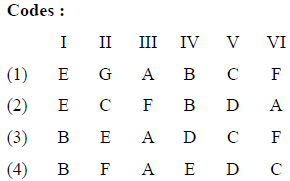
Latest Govt Job & Exam Updates: